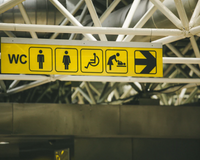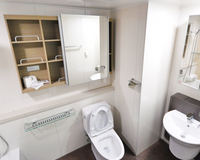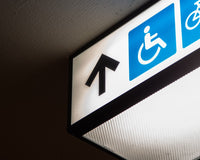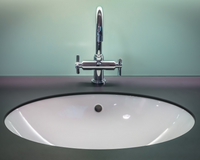The Americans with Disabilities Act (ADA) ensures that businesses are accessible and welcoming to all visitors. The standards put into place by the ADA require businesses to meet certain layout requirements or have access to specific fixtures in all spaces.
One of the most common features the ADA requires is the installation of grab bars. These allow people with physical limitations or mobility challenges to use restrooms comfortably and safely.
Choice Builder Solutions understands the process of designing and creating a restroom intended to accommodate all individuals. We will explain the ADA standards for installing commercial restroom grab bars, so your establishment can make the facilities accessible while meeting all regulatory requirements.
The Purpose of Grab Bars in Commercial Restrooms
Grab bars provide the necessary support for people who may have trouble balancing, rising, or lowering themselves while using restroom facilities. These seemingly simple metal bars provide lifesaving aid that greatly reduces the risk of slipping or falling. Business owners can provide functional, safe, and accessible restroom environments to all users by following basic ADA guidelines.
Legal Requirements for ADA Compliance in Restrooms
Business owners should understand the importance of the ADA rules to protect people with physical ailments or disabilities. Failing to adhere to these rules risks potential legal actions and lawsuits. Not to mention, it may send a negative message about your company’s values toward inclusivity.
The ADA outlines specific standards for the installation of grab bars to ensure uniformity and functionality. These rules cover dimensions, positions, installation heights, and the characteristics of grab bars to make them effective and accessible for everyone.
Wall-Mounted Grab Bars vs. Free-Standing Restrooms
It’s always a smart idea to figure out where your grab bars are the most effective before you start installing any items. Most commercial restrooms require wall-mounted bars that are sturdy anchors to support people’s weight.
Certain restroom layouts may not have the space or layout for wall-mounted bars. You should consider alternative ADA-compliant options like bars attached to restroom partitions or floor-mounted supports. Regardless of placement, account for optimal usability for individuals who rely on mobility aids like walkers or wheelchairs.

ADA-Compliant Placement of Grab Bars
ADA standards establish that location is an important factor for grab bar functionality. Restrooms typically require two main types of bars.
The first is a horizontal grab bar that goes behind the toilet, while the second should go along the side wall closest to the toilet. Their specific placement works to provide support during lateral and vertical movements, such as transitioning from a wheelchair to the toilet seat.
For example, the rear grab bar must extend across the entire wall behind the toilet, while the side grab bar must start at least 12 inches away from the rear wall to allow sufficient space for maneuvering. These placements allow users to hold onto grab bars effectively without obstruction.
Height and Length Specifications
While looking into placement, you should consider the height and length of the grab bars themselves. The ADA specifies that grab bars must be between 33 and 36 inches above the finished floor. This range serves as a mostly universal metric to accommodate a wide range of individuals of varying heights and abilities.
Length requirements are equally important. The rear grab bar behind the toilet must measure at least 36 inches in length, ensuring sufficient coverage for stability. The side bar normally requires a slightly longer length; the ADA states that around 42 inches is acceptable. These dimensions help ensure accessibility and efficiency regardless of size or mobility limitations.
Structural Anchoring and Load Capacity
Securely mount the grab bars to sustain a large amount of force and weight. Adhering to ADA standards means these grab bars should withstand at least 250 pounds of force with loosening or detaching. Properly anchoring the grab bar to a reinforced wall or similar structure will ensure the bar achieves the appropriate level of strength.
Improper mounting is one of the most common errors made during installation. Business owners should work alongside contractors to properly secure grab bars into studs, anchors, or reinforced backings.
Surface Design and Grip Standards
When considering the ADA standards for installing commercial restroom grab bars, the surface of the bars plays an important role in their usability. ADA-compliant bars should have nonslip finishes to provide users with a secure grip, even if their hands or the bar itself is wet.
Smooth or polished grab bars may be aesthetically pleasing, but they pose more hazards, making them less effective for people to rely on. Make sure the material features a textured or matte finish to provide people with a better grip.
Next, consider the diameter of the grab bar. This will allow users to comfortably wrap their hands around the bar without issue. Most ADA-compliant grab bars measure between 1.25 and 2 inches in diameter, providing a comfortable grip for most users.

Proper Clearance Around Grab Bars
Clearance is another important factor for grab bars. The ADA requires a minimum horizontal clearance of 1.5 inches between the wall and the grab bar itself. This gap helps prevent fingers or knuckles from coming into contact with the wall while gripping the bar.
Bathroom layouts should also make sure that any nearby objects or fixtures—like paper towel dispensers or soap dispensers—do not obstruct or limit access to the grab bar in any way. Maintaining adequate clearance ensures the bars are convenient and safe to use.
Common Installation Mistakes To Avoid
Even with the best intentions, improper installation can lead to noncompliance with the ADA and hazards for users. Some common mistakes to look out for include
- attaching grab bars to insufficiently reinforced walls,
- mounting bars too high or too low,
- installing shorter bars than the ADA recommends,
- and using substandard materials that don’t meet the weight-bearing or grip requirements of ADA regulations.
By thoroughly understanding and adhering to ADA specifications, business owners can avoid these pitfalls and create spaces that meet accessibility standards.
Partner With Professionals for ADA-Compliant Installation
Given the specificity of ADA requirements, many business owners find it beneficial to consult with professionals for restroom grab bar installations. Hiring professionals gives you the advantage of long-term durability and seamless integration of grab bars into your restroom. Many professional companies understand the intricate requirements and can ensure that your bathroom is safe, accessible, and legally compliant.
For expert guidance and high-quality installation of commercial bathroom grab bars, Choice Builder Solutions is here to assist. Ensure your business meets ADA standards while creating a safe and welcoming environment for all. Contact us today to discuss your facility’s ADA renovation needs.





